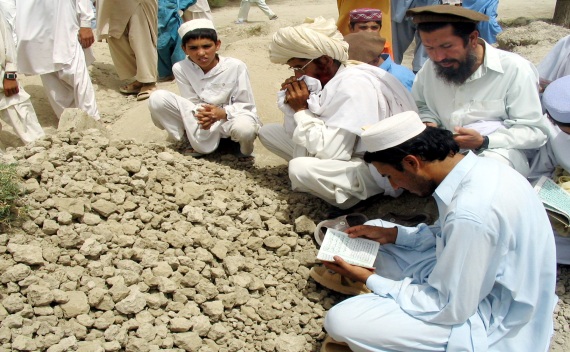Pakistan, America, and Journalistic Courage
More on:

In 2005, U.S. and Pakistani intelligence and military personnel were tracking Abu Hamza Rabia, a senior Al Qaeda official involved in the 2003 assassination plots against Pakistani President Pervez Musharraf. Eventually, Rabia was tracked to the Mosaki village in the North Waziristan province near the Afghan border. On November 5, a CIA-controlled Predator drone fired one or more Hellfire missiles at a house in Mosaki, reportedly killing Rabia’s wife and daughter and six others. Rabia was wounded, but narrowly missed being killed.
Three weeks later, Rabia was tracked to the village of Haisori. On December 1, at 1:45 a.m., a Predator fired Hellfire missiles at a mud-brick compound in Haisori, killing Rabia, a Syrian bodyguard, and the seventeen-year old son and eight-year old nephew of the owner of the house. At the blast site, villagers uncovered pieces of shrapnel bearing the Hellfire’s designation “AGM-114,” the words “guided missile,” and the initials “U.S.” To conceal American involvement, the Pakistani government created a flimsy cover story that Rabia blew himself up experimenting with explosives.
We only know that the villagers of Haisori found physical evidence of the American drone strike because freelance journalist Hayatullah Khan filed a story and photographs with the Urdu-language daily Ausaf, with the pictures further distributed around the world by the European Pressphoto Agency (EPA). (You can see Khan’s photographs of the blast site on the EPA website by entering “Hayatullah” in the image search.)
The day after Khan’s story was published, his car was run off the road and he was abducted by five armed men. Six months later, his body was found in a Miran Shah marketplace, handcuffed and shot in the head from behind. Although a Peshawar High Court Justice investigated Khan’s disappearance and submitted his findings in August 2006, the results have never been made public. Khan’s family, meanwhile, has always accused Pakistani intelligence officials of authorizing the detention and murder of Hayatullah Khan.
The State Department’s 2006 Country Report on Human Rights Practices for Pakistan described the Khan murder delicately, indirectly implicating Pakistani officials, while denying the existence of the CIA’s Predator drones:
“Colleagues suspected that authorities detained Khan after he contradicted a government report that the senior leader died when munitions exploded inside a house. Khan quoted local tribesmen as saying the house was hit by a missile fired from an aircraft.”
Abu Hamza Rabia was the most prominent high-value al-Qaeda official killed in the early years of the CIA’s killing-by-drone program over the tribal areas of Pakistan. Hayatullah Khan, meanwhile, was an unintended early casualty of the drone campaign, murdered for having the courage to report on the facts as he saw them, which directly contradicted the Musharraf government’s sanitized version of the events.
The important work of Khan is worth remembering as the world awaits the results of a Pakistani judicial commission “for in depth probe of the mysterious assassination of journalist Saleem Shahzad,” according to a Pakistan Supreme Court statement. Shahzad vanished on May 29, after reporting alleged connections between al-Qaeda and Pakistani Naval officials. His body was found two days later seventy-five miles south of Islamabad, the victim of torture before his murder. Shahzad had told colleagues for months that he received specific death threats from officials from the Pakistani Inter-Services Intelligence (ISI) Directorate.
Last week, Dexter Filkins reported that, according to an anonymous American official, “reliable intelligence indicates that the order to kill Shahzad came from a senior officer on General [Ashfaq Parvez] Kiyani’s [Chief of Army] Staff.” Filkins charges were, in part, confirmed by a remarkable mid-July press conference with Admiral Michael Mullen, Chairman of the Joint Chiefs of Staff. Mullen noted of Shahzad the “huge concern I’ve had with respect to both the disappearance and obviously finding him dead,” adding that, “his isn’t the first, it is– for whatever reason, it has been used as a method historically.” When pressed whether the Pakistani government had authorized Shahzad’s detention and murder, Mullen admitted: “Yeah, that it was sanctioned by the government, yeah.”
Hayatullah Khan was only one of thirty-five Pakistani journalists that have been killed in Pakistan because of their work since 2001, according to the Committee to Protect Journalists (CPJ). The motive behind Saleem Shahzad’s death remains undetermined by the CPJ, and the judicial commission investigating his killing will not release its findings for many months, if ever. It is not surprising that Pakistan remains “not free”—based on legal, political, and economic criteria—for journalists, according to Freedom House.
We have few reliable insights into Pakistan, from the proliferation of militant networks both in the tribal areas and the cities, the expanded scope and intensity of CIA drone strikes, and the connections between Pakistani government employees and Taliban-affiliated groups. To limit scrutiny into each other’s semi-secret operations—and protect the principle of Pakistani sovereignty—neither Pakistani nor American officials are consistently dependable sources of information. Without the tireless work of Pakistani journalists, our understanding of the political and security dynamics in Pakistan—including the role of America’s military and intelligence assets—would be severely diminished, which is exactly what some officials in both countries want.
More on:
 Online Store
Online Store
